The winner – Omnisend
Life-changing superhero
In this comparison, Omnisend wins six out of eleven rounds. Three rounds end in a tie, and there are only two aspects where Mailchimp outperforms Omnisend. Continue reading to learn about the situations where Omnisend outperforms Mailchimp and why.
What Omnisend features are better than Mailchimp?
- Getting started experience
- Email building features, email templates and the Campaign Booster
- Marketing automation access for all users, multiple ready-to-use templates
- Signup form library with multiple copy versions and designs
- Customer support 24/7 for all customers
- Pricing (better value for price)
- You need a credit card to get started and see more features
- Email templates are available on paid plans only
- Marketing automation features on higher-tier plans only
- There is no signup form library, one popup at the time
- Free plan users get support only first 30 days
- Although price is slightly lower, advanced features for ecommerce are available only with higher-tier plans
Mailchimp vs Omnisend: which one is better? Well, that depends on your specific needs.
While Mailchimp is more generic, Omnisend is designed keeping ecommerce businesses in mind.
In this review, we’ll dissect each tool’s features, Omnisend and Mailchimp pros and cons, and pricing, to help you pick the one that fits your business best.
Mailchimp vs Omnisend: A quick overview
Both Mailchimp and Omnisend are easy-to-use email marketing platforms with strong automation and personalization features.
However, Mailchimp is more generic and has a wide range of features that are suitable for all types of businesses. Omnisend, on the other hand, is a more specialized email automation tool built with ecommerce businesses in mind.
Both are very popular in the Shopify ecosystem. In terms of customer evaluation, Mailchimp has a not-so-great rating of 3.5 out of 5 while Omnisend has a stellar 4.8-star rating for the same on Shopify App Store.
Here’s a quick overview of Omnisend vs Mailchimp features.
This next section discusses some key features these email marketing platforms offer, from segmentation, ease of use, and personalization, to customer support and more.
Omnisend vs Mailchimp comparison: Feature by feature
Here’s a feature-by-feature comparison of Mailchimp vs Omnisend to help you make the right choice for your business.
Ease of getting started
Which one’s easier to use, Mailchimp or Omnisend?
Truth is, both tools have a user-friendly interface, and getting started is relatively easy. But Omnisend doesn’t require a credit card to sign up for its free plan, while Mailchimp does require it for its free trial.
As recommended, we connected both tools to our Shopify store. They both integrated very smoothly within a few clicks, which was a very good experience.
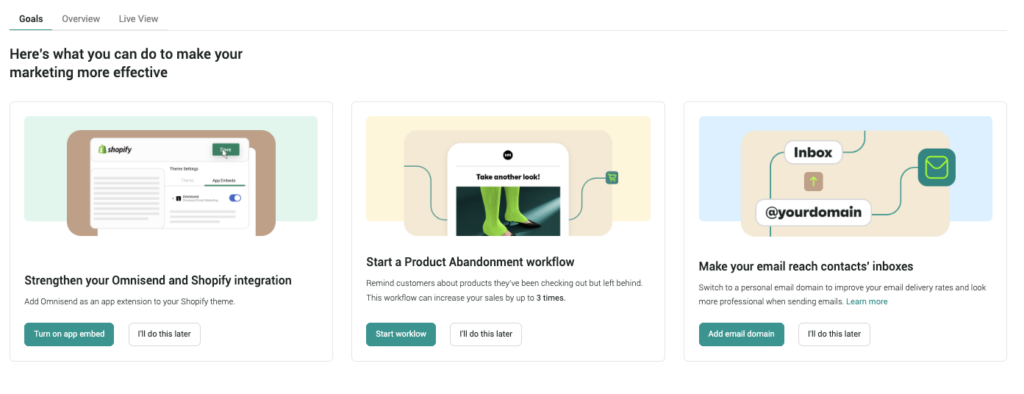
Also, both tools provide onboarding steps that are useful for beginners with little experience with such platforms. And while the Omnisend interface as well as Mailchimp interface is intuitive, we found it difficult to find certain things on Mailchimp platform, such as the landing page builder or how to remove the Mailchimp logo from the email.
Omnisend makes it easier to find these items.
The first round goes to Omnisend.
Building an email campaign
Both Mailchimp and Omnisend have intuitive email campaign builders that you can use to create different types of campaigns, such as regular newsletters, A/B test campaigns, and automated emails.
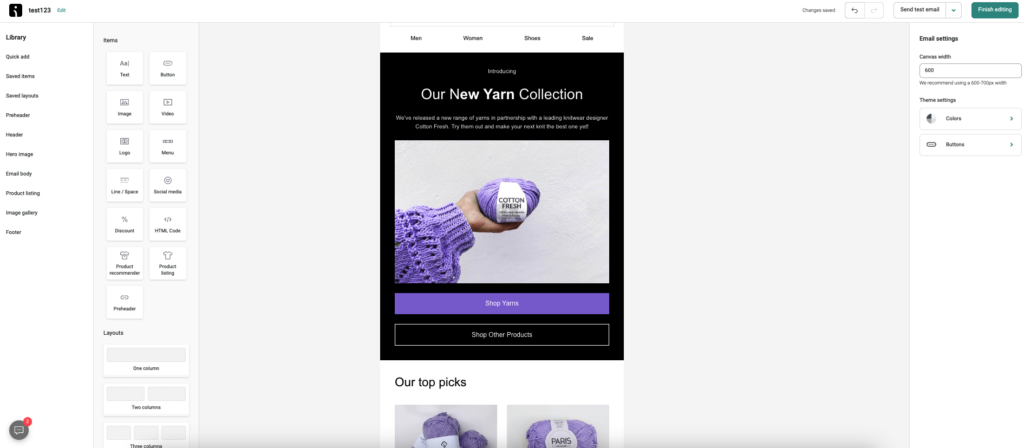
Both feature drag-and-drop editors that make it easy to add content and other elements to emails.
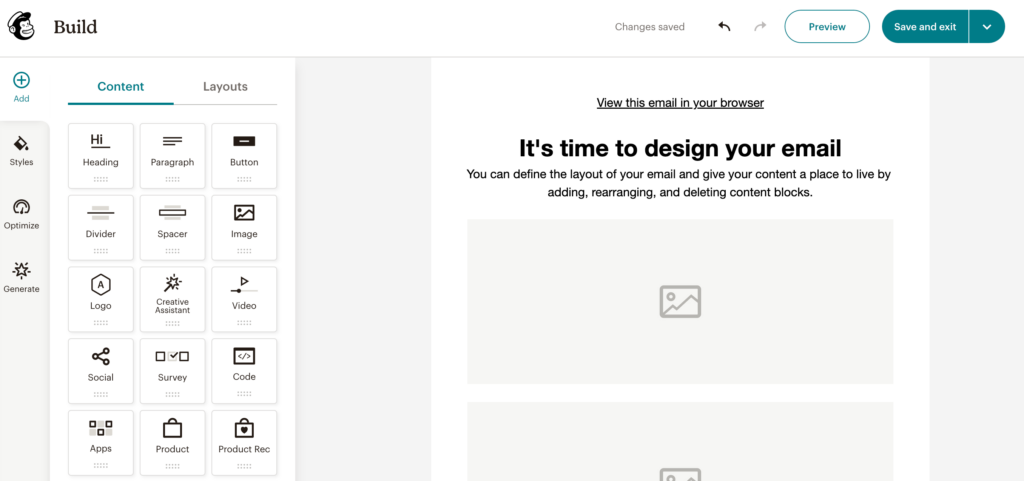
Here’s a quick comparison of Omnisend and Mailchimp in terms of their email building capabilities.
The main problem with Mailchimp is that many features like the option to code your own HTML email templates and email scheduling are only available with the higher tier plans. Meanwhile, Omnisend unlocks almost all of its features (except advanced reporting, which is only for Pro plan users) for all customers.
Here are some other areas where Omnisend shines.
Its email editor has a “Quick Add” section that makes it easy to drag-and-drop content blocks into your email draft. This saves a lot of time.
Omnisend’s Product Picker allows you to add products to your emails directly from your store. It also offers unique ecommerce features, such as product recommendations and unique discount codes.
Omnisend email templates are compelling, mobile-friendly, and available on all Omnisend pricing plans. You can also design HTML emails across the board.
The fact that Omnisend lets you create modern-looking, unique email campaigns even with its free plan gives it a huge advantage over Mailchimp.
Omnisend wins round 2!
Marketing automation
You can create advanced automated workflows on either platform based on certain triggers. They also offer prebuilt automation templates.
Omnisend’s automation library includes 30+ pre-built templates for:
- Welcome emails
- Cart abandonment reminders
- Special occasion emails, such as birthdays, anniversaries, etc.
- Post-purchase communication and more
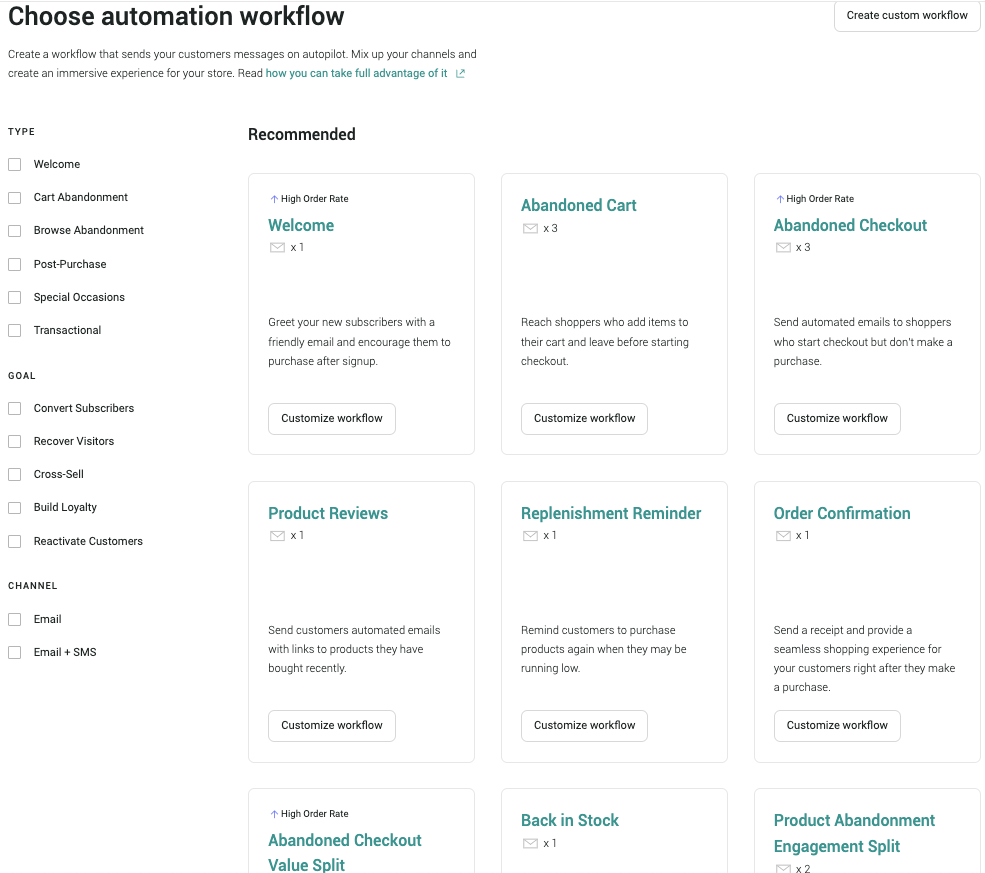
Unlike Mailchimp, these templates contain not only automation logic and rules but also copy suggestions. So you can launch these emails in a minute without any pricing limitation.
In Omnisend, you’ll find a decent list of triggers, filters, and conditional splits that can help you make your messaging highly personalized and relevant.
You can also integrate SMS and push notifications to your automated workflows. Mailchimp introduced SMS marketing just recently.
The downside is that you only get historical data of up to 18 months and even that is available for Pro plan users only.
Now, let’s take a closer look at Mailchimp automation capabilities.
It offers 70+ customer journey templates that include social media channels, SMS and emails.
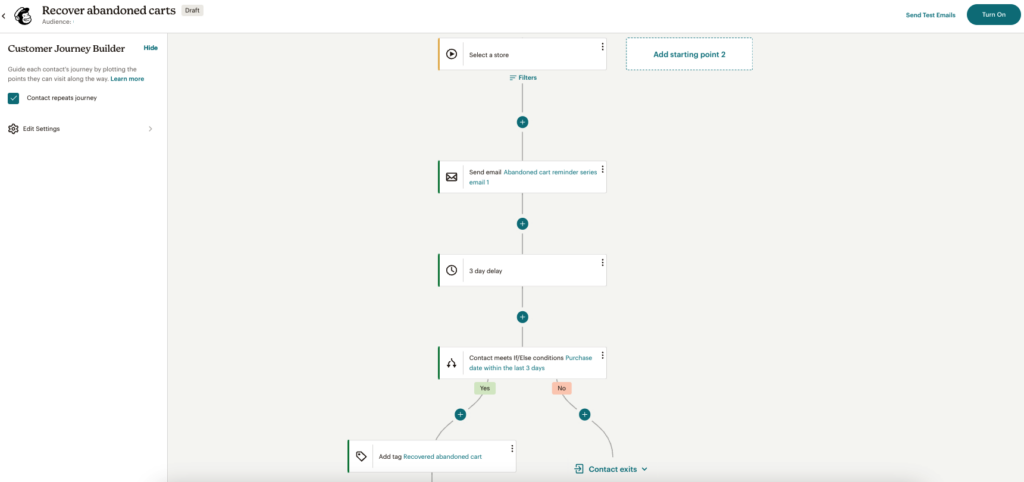
Mailchimp’s automation features are limited by pricing plans. With the Premium plan, you can get all that Omnisend offers, including pre-built templates, conditional automation, advanced segmentation, and comparative reporting. However, for lower tier plans, these features are limited.
Omnisend is the winner here. Omnisend offers more features on all pleans, while Mailchimp attaches them to the higher-tier pricing plans.
Signup forms and landing pages
Mailchimp and Omnisend integrate easily with most websites making it easy to add signup forms and build email lists.
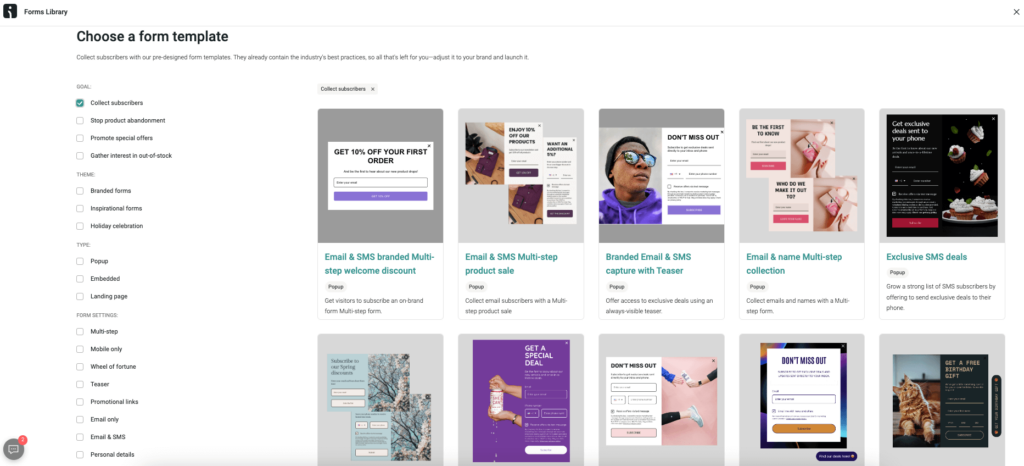
Both platforms have excellent built-in signup form and landing page builders that customers can use to design their creatives. However, Omnisend provides ready-to-use prebuilt forms while on Mailchimp you need to design forms from scratch.
Here’s a quick comparison of the features offered by Omnisend and Mailchimp.
Omnisend is the clear winner here as it’s much easier to design forms using its prebuilt templates. It also offers a variety of forms, including gamified ones like Wheel of Fortune. And you don’t have to worry about repeating customers in your database.
Segmentation
Segmentation helps you target your audiences based on unique traits, such as demographics, location, and purchasing behavior. This allows you to create more personalized emails that are relevant to each target audience segment.
Omnisend offers 30 prebuilt segments and 6 segmentation criteria, which are:
- Channel
- Email campaign activity
- SMS campaign activity
- Shopping behavior
- Contact properties
- Web browsing activity
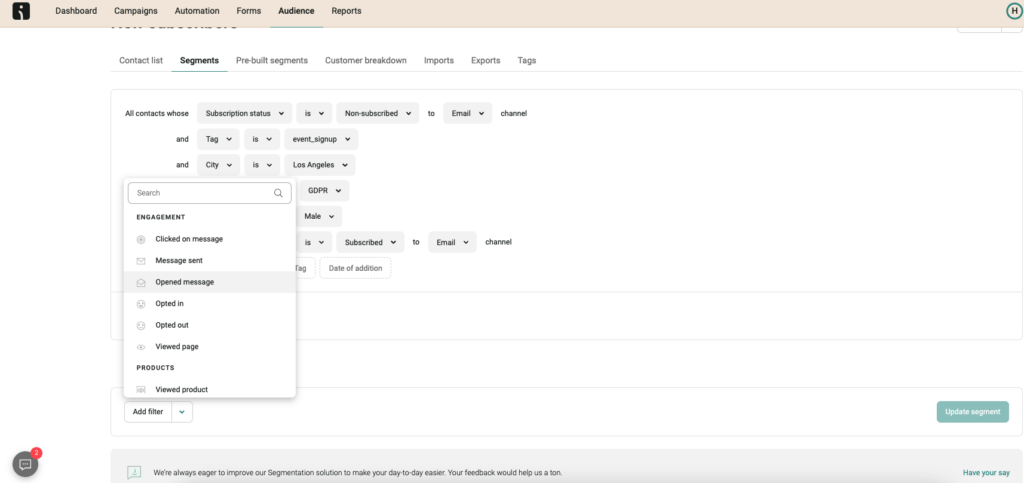
You can also use “AND”, and “OR” conditions for advanced segmentation. However, this can be a bit complex for beginners.
Mailchimp, on the other hand, offers only nine ready-to-go audience segments. Each segment can have up to five segmentation conditions.
Mailchimp’s dynamic content block allows you to show different sections of an email to different audiences. This allows you to target multiple audiences with the same email campaign.
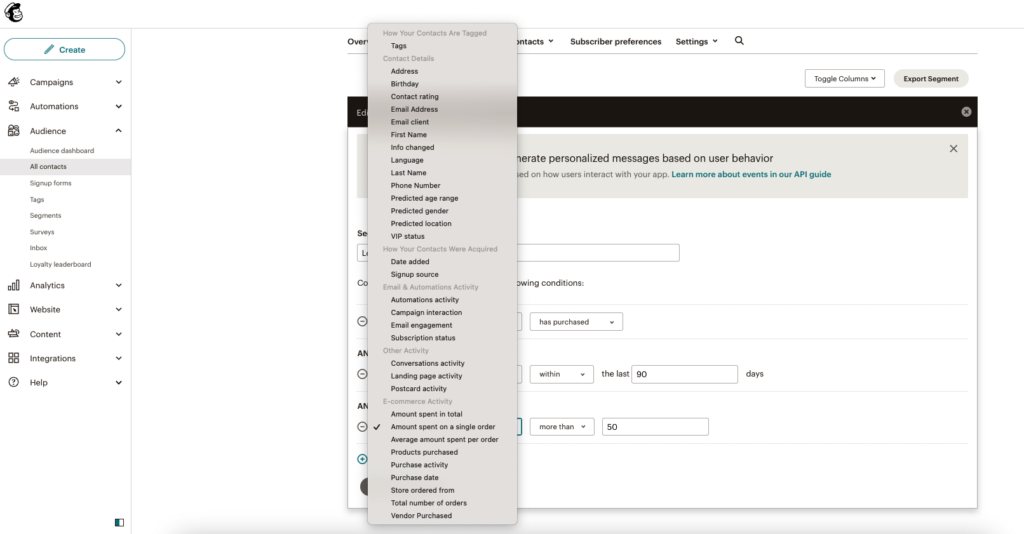
Mailchimp’s segmentation options on lower-tier plans are enough for most businesses. However, you can unlock advanced conditional segmentation capabilities with the Premium plan.
What’s missing?
Mailchimp doesn’t offer advanced segmentation with its lower-tier plans, but it’s good enough for beginners. While Omnisend offers these features, it misses out on the element of simplicity.
Overall, both tools offer pretty extensive segmentation capabilities based on various parameters. It’s a tie.
Analytics
Omnisend tracks your data based on customer interactions with your store, emails, SMS, website, and other integrated platforms. As a result, you’ll get data related to metrics like:
- Revenue, orders, and purchases
- Open rates and click-through rates
- Device activity
- Activity on messages sent
- Bounce, unsubscription, and spam rates
Omnisend’s reporting dashboard is pretty straightforward. You can easily monitor your website activity even in real time.
Customers on the Pro plan enjoy advanced reporting features, such as viewing the campaigns and automation that are delivering the highest performances. In-depth business insights such as specific segment performance and customer breakdown reports are available. Mailchimp doesn’t have these two.
On the other hand, Mailchimp email metrics are more extended. Apart from the reporting data mentioned above, Mailchimp provides additional statistics, such as:
- The number of times your campaigns were forwarded and opened by the person they were forwarded to.
- The website report shows how many unique anonymous visits you had today and how many of those ended up subscribing.
- How well your campaigns are doing across different social media platforms.
- Geolocation tracking to show where your emails are being viewed and opened.
You’d need to turn your open and click settings on in your campaign to get these reports.
Mailchimp comparative reports are available on its Standard and Premium plans. Furthermore, Mailchimp has direct integration with Google Analytics to take your reporting to the next level.
Overall, Mailchimp has more to offer in terms of ecommerce reporting compared to Omnisend.
Customer support
Mailchimp offers customer support depending on which plan the user is on. For starters, users on the free plan only get email support for the first 30 days, after which they’re on their own. This could be frustrating for businesses on a budget.
Even for paid plans, customer support options still vary.
- Essentials: 24/7 email and chat support
- Standard: 24/7 email and chat support
- Premium: Phone and priority support
Omnisend provides round-the-clock email and live chat customer support to all its users, even those on the free plan. As a matter of fact, the platform has a Stevie Award for the excellent customer support it offers.
Omnisend also offers 24/7 priority support to customers on its highest plan. The average response time for Omnisend’s customer representatives, according to most customer reviews, is 3 minutes.
Pretty quick, isn’t it?
Finally, both platforms offer numerous DIY resources including tutorials, a help center, a knowledge base, and blog posts.
What’s missing?
Mailchimp’s free plan deserves some level of customer support after the first 30 days. It leaves the customers to fend for themselves after the first month.
It’s a no-brainer. Omnisend wins this round.
Integrations
If you’re looking for a suitable email marketing tool for your ecommerce store, then you’d be particularly interested in ecommerce integrations.
Omnisend has seamless integrations with major ecommerce platforms like Shopify, Shopify Plus, WooCommerce, BigCommerce, OpenCart, etc.
Apart from that, there are over 130 other integrations with Omnisend available.These include:
- Middleware apps like Zapier
- Advertising platforms like Google Ads and Facebook Lead Ads
- Shipping and logistics apps
- Loyalty and rewards apps
Mailchimp, however, has much more to offer as far as integrations go. The platform boasts over 300 integrations, so you’re more than likely to find anything you need.
From CRM, ecommerce, customer support, payments, and accounting to socials and design — it’s got everything. You’ll find integrations with tools like QuickBooks, Shopify, Stripe, Zendesk, WordPress, and more.
What’s missing?
Omnisend needs to up its game in terms of integrations. It could do with more direct integrations to help users get more from their subscriptions.
Mailchimp wins this round for its numerous integrations.
Compatibility with other marketing channels
Both tools allow access to other marketing channels besides email.
For instance, Mailchimp’s integration with social media platforms like Facebook, Instagram, and Google allows you to retarget your campaigns to prospects who are already familiar with your brand. Mailchimp recently launched SMS marketing for US users. Mailchimp SMS pricing can be found in the pricing section.
The Google remarketing ads feature on Mailchimp also lets you retarget prospects who browsed your website. This saves you the time you would have spent sending cold campaigns to new audiences altogether.
While social retargeting is available on both platforms, Mailchimp limits this function to its top plans.
The Mailchimp campaign manager that allows you to consolidate your omnichannel marketing into a single dashboard is only available on the Standard and Premium plans.
Omnisend has a similar function, with its audience sync for ads feature available on all plans. This function lets you sync your contacts with Facebook and Google using their email addresses so you don’t have to use cookies.
You can then sync your Omnisend account with your Facebook Ads and Google Ads accounts and retarget these customers.
Omnisend syncs your contacts to Facebook every 15 minutes to keep your audience relevant.
Omnisend also provides SMS marketing and web push notifications. It allows you to integrate these channels into your marketing campaigns for maximum impact.
Both Omnisend and Mailchimp can offer sufficient omnichannel marketing capabilities.
Mailchimp vs Omnisend: Price comparison
Mailchimp’s free plan used to be generous, but now it’s become more limited compared to most email marketing tools out there.
For free you get the most essential features and to send up to 1,000 monthly emails to up to 500 contacts.
With Omnisend, you can send 500 monthly emails, 60 SMS, and 500 web push notifications to up to 250 contacts. However, unlike Mailchimp, Omnisend offers full access to the most advanced features on the free plan.
Here’s a quick overview of the two free plans and the features they offer.
Free plans comparison
- Professionally designed customizable email templates
- 24/7 email and chat support
- Prebuilt signup forms including popups and landing pages
- Sales and performance reports and analytics
- A/B test
- Unlimited segmentation capabilities
- Prebuilt automation and workflows
- Limited prebuilt email templates (mostly basic)
- 30-day email support
- Signup forms and a landing page builder
- Basic analytics and reporting
- Creative assistant
- Numerous integrations
- One user, one audience
The features offered on Omnisend’s free plan are more than any other email marketing tool out there. Small, zealous businesses that are scaling on a budget can find Omnisend’s free tool very useful.
The Essentials and Standard plans by Mailchimp offer a few additional features like:
- A/B testing
- Email scheduling
- Automated workflows
- Better email templates
- Predictive segmentation
Most of these features you can already access on the Omnisend free plan and on a larger scale with Omnisend’s Pro plan. This makes Omnisend’s pricing more worthwhile compared to Mailchimp’s, even for the paid plans.
The significant price jump from Mailchimp’s Standard plan to the Premium plan seems unrealistic, considering that there are very few additional features to be unlocked.
A notable difference in pricing is the inclusion of SMS credits. Unlike Mailchimp, where SMS credits are not included in the plans mentioned above, Omnisend already incorporates SMS credits in its offerings. Therefore, if you choose to send SMS messages with Mailchimp, you will need to factor in these additional expenses to your preferred pricing plan.
Omnisend doesn’t require users to fill out their credit card details when starting out on their free plan. Conversely, Mailchimp asks for credit card details for free trials.
Mailchimp SMS pricing
SMS is available as an add-on to US paid plans only. The SMS credit packages start at $20 per month.
Standard vetting is included when you purchase 5,000 or more SMS credits. If you buy fewer than 5,000 credits, standard vetting is available with the Premium plan.
Omnisend SMS pricing
With Omnisend, you can buy SMS credits no matter what plan you are on.
All pricing plans, including Free plan offer a decent amount of free SMS. If you need more, you can buy additionally. Moreover, Omnisend sends SMS worldwide, unlike Mailchimp.
However, the price per message is higher than Mailchimp offers. It’s $0,015/SMS and it remains the same regardless the number of text messages you send.
Summary - which one wins?
Omnisend or Mailchimp, which one’s best for your business? The answer ultimately depends on your email marketing needs.
4.8
4.5
500 subscribers – $16
1000 subscribers – $20
5000 subscribers – $81
10,000 subscribers – $121
50,000 subscribers – $413
100,000 subscribers – $900
500 subscribers – $13
1000 subscribers – $27
5000 subscribers – $75
10,000 subscribers – $110
50,000 subscribers – $385
100,000 subscribers – $800
– All Pro features
– Reach up to 250 contacts (unlimited contact list size)
– 500 emails/mo
– Up to 60 SMS
– Up to 500 web push
– Free trial is for 30 days, you can test out the majority of paid features
– 1000 email sends/mo
– A few basic email templates
– 30 days email support
– Robust automation
– Advanced analytics
– Beautiful signups forms
– Modern looking newsletters
– The tool has a very wide range of features
– Mailchimp has a lot of integrations
– The tool is user friendly
– Doesn’t provide geopolitical reports
– More expensive than Mailchimp for small contact lists
– Mailchimp charges for email duplicates
-Very limited free plan, and paid plans get expensive quickly
– Email templates available on Free plan are too basic for current ecommerce needs
Ecommerce stores of all sizes
Solopreneurs, startups, bloggers, non-profit organizations
Non-ecommerce businesses
Ecommerce stores that are in their active growth stage
Mailchimp comes with far more features, but the catch is that most of these features are available for higher tier plans only. The pricing is fair for lower plans and expensive on the Premium plan.
Omnisend, on the other hand, is a specialized ecommerce marketing tool with robust features and affordable plans. The tool provides advanced automation workflows that are easy to navigate and offers 24/7 customer support in case you get stuck.
This puts Omnisend a few steps ahead of Mailchimp as an ecommerce email marketing platform.
Read full reviews
Our team strives to be accurate and unbiased in reviewing email tools. However, we recognize that mistakes can happen, and it’s essential for us to stay up to date. If you come across any errors or things that need to be reviewed again, please let us know.




